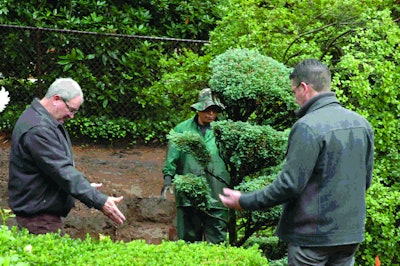
Avoid these common pitfalls to keep your business (and your landscapes) healthy
Whether you’ve been in business a season, a decade or a lifetime, you’re going to experience the occasional misstep. But mistakes aren’t necessarily what put your company at risk: it’s not learning from your slip-ups.
“If you think you or your staff won’t make mistakes, you’re delusional,” says David Katz, one of TLC’s 2013 Landscaper of the Year finalists and owner of Elite Landscaping in Poughkeepsie, New York. “But mistakes are opportunities for growth, and the mistakes you make have been made by many others before you.”
Here are a few of the most common blunders that can impact your ability to sink or swim.
1. Not running your business like a corporation
Without question, one of the biggest stumbling blocks to long-term success is not acting like a professional.
“Everything you do communicates to the client and the general public a perception of the entire profession,” says Phil Allen, Ph.D., landscape industry certified manager and professor of landscape management at Brigham Young University in Provo, Utah. “Make sure you have the appropriate licenses, certifications and insurance. Bill in a timely manner, and be willing to seek outside expertise, such as an accountant versed in small businesses, when it comes to crucial issues such as taxes.”
2. Not training employees adequately

“You’ve got to foster a learning environment within your company,” Allen says. “You also need to emphasize a culture of safety. Especially in smaller companies, one safety mistake, and you can be out of business.”
Make employees understand that wearing personal protective equipment (PPE) is essential, not optional. Encourage crews to warm up and stretch before getting to work to avoid injuries. Invest in education with regular training sessions, whether it’s informal one-on-one time with a shovel or weekly tailgate chats about safety.
3. Underbidding to get the job
Repeatedly lowballing bids just to keep your crews busy is not a sound business decision.
“We’ve all done that at one time or another to get a foot in the door,” says George Pacheco, president and CEO of Pacheco Brothers Gardening, Inc. in Hayward, California. “But that can get you in trouble if you’re working on volume alone. Know your break-even point. Know your expenses exactly. If you’re consistently making your margins, you won’t go out of business.”
4. Not communicating well with clients and staff

“Be as clear as glass about what your are delivering and what you are expecting from both your staff and your clients,” Katz says.
Assume nothing. Research your bids, put them down in writing and make sure you follow up in person. Oftentimes, the personal touch is what seals a deal.
5. Not understanding the project before bidding
What looks like a simple project often turns out to be far more involved than you first anticipated.
“Walk the whole project. Look at the back forty so you understand the complete job and what it entails,” Pacheco says.
Don’t forget to factor in drive time to a jobsite. Get another set of eyes within your company, such as your operations person or crew leader, to look at a project and talk it over.
“A second or third opinion is invaluable and helps give you the right numbers to bid the job accurately to make your margins,” says Pacheco.
6. Improper planting techniques
“You can’t just dig a hole and toss in a plant,” says Fred Kapp, educational director of the Alabama Green Industry Training Center in Birmingham, Alabama. “Plants dying on a job make you look bad. Learning the right way to install plant materials will save you time, money and your reputation.”
Common mistakes: Piling up mulch in a volcano shape around a plant base; chipping out a hole for a plant instead of breaking up the soil into a bed in which the root system can expand fully; not locating topmost roots when planting and placing it at grade or higher; and not removing girdling roots in container plantings.
7. Not continuing to educate yourself
“Even if you’re not formally educated in horticulture, you can become a plant person,” Kapp says.
Spend time at a local landscape nursery, go to botanical gardens, read as much as possible and do a search online to make sure you’re choosing the right plant for the conditions.
Make sure to utilize all of the different resources such as the Green Industry Web portal, which offers free videos and instruction on landscape techniques. The same goes for the operational aspects of your business. Keep learning how you can improve by joining professional organizations, going to trade shows and networking with others in the trade.
8. Not creating a functional and attractive design

Mix it up with different textures and evergreens, but don’t overcrowd plants. “Sometimes less is more. Jamming in a bunch of plants looks great in year one. But by year three, you have a maintenance nightmare, which isn’t going to please your client,” Bryson says.
Finally, avoid using the same plants over and over, which is not only boring but also puts the entire landscape at risk if a particular pest or disease strikes.
9. Not paying attention to your reputation
More so than many industries, the landscape profession relies on word of mouth to build your clientele base.
“You can have a website with pretty pictures, but your work in the field and your reputation are largely what determine your success,” Bryson says. Be reliable, and deliver what you’ve promised. Return calls within 24 hours, no matter how busy you are. Continually educate yourself about plant materials, laws and safety issues.
Also, make sure your crews reflect the professionalism you are striving to achieve: Invest in uniforms or T-shirts with your company logo. Keep your trucks neat and clean, and make sure your crew is acting appropriately on jobsites.
10. Comparing yourself to other companies
“Don’t look at other long-established companies and think they’re perfect,” Katz says. “Every company has its own issues. They may be different problems from what you’re facing, but we all have challenges.”
Instead, find your niche and learn as much as you can about it. Consider hiring a consultant. Join the Chamber of Commerce or local Rotary club, and attend meetings for networking opportunities. Every person you meet is a chance to score your next big project, and getting your name out there is the first step.











